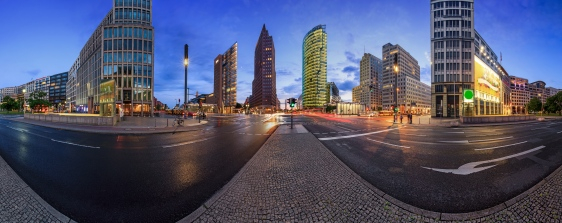
Artistic and architectural expression go hand-in-hand in a Berlin still in the making. Many of the city’s modern architectural landmarks are cultural institutions — and both artists and architects have played a pivotal role in reshaping the city. The evolution of the Berlin cultural scene over the past two decades has accompanied that of the city itself.
Following the 1996 conversion of the old Hamburger Bahnhof train station into a stunning modern art institution, the Museum für Gegenwart, some 30 museums have since been housed in new or refurbished buildings.
The vigorous sense of creative freedom is discernible as you stroll, metro or bike about Berlin’s museums and galleries, or sip coffee and enjoy Turkish and Middle Eastern food in arty districts such as Prenzlauer Berg or Kreuzberg. The latter is home to the Berlinische Galerie, a powerhouse of local art encompassing photography and architecture from the 1870s to contemporary times, sweeping in Expressionism, Berlin Dada, art in the Nazi era and postwar period. Located a few hundred meters from the Mauerweg Wall Trail and Checkpoint Charlie Wall Museum, the white block-and-glass structure in lawns of yellow letters features works by dozens of resident Berliners. Light streams into the building from every direction, as it does with many of Berlin’s modern architectural and art marvels, though a lot of the art remains very dark, especially that of former GDR artists.
There’s the landmark red hexagonal topped Tower Restaurant Steglitz of 1980 and futuristic green-glassed Photonics Centre of 2001 alongside architect Peter Ruge’s alternative Bambooline Berlin project in 2012, which dreamt up plans for turning an asbestos-polluted building in the old no man’s land between west and east Berlin into a CO2-reducing tower.
Stepping into the light
That and another dozen projects, says Ruge, aim to transform parts of the city “from a wasteland to sustainable centres”. Across many of the developments that have changed the face of the city over the past two decades, light seems to be an obsession in both architecture and art — illuminating once gloomy parts of the city and lighting up imaginations.
The preponderance of glass buildings, cupolas, domes and other structures made to let in light is personified in the honeycomb-like dome of the Parliament, the Reichstag. For Christoph Kucklick, Editor-in-chief of Germany’s GEO Magazine, the phenomenal tentroofed Sony Centre on the Potsdamer Platz took Berlin to new architectural heights.
“Opened in 2000, it was the take-off point and emblem of the new light-filled city. Modelled on Japan’s revered Fuji Volcano, the audacious tilting design of the colossal dome by architect Helmut Jahn underscores even more the idea of dynamic and eruptive energy which has shaped Berlin.”
Even Berlin’s oldest institutions are being given a modern makeover. The already dramatically re-looked Museumsinsel — the Unesco-listed ensemble of 19th-century Prussian buildings on an island in the River Spree — is still undergoing a facelift begun in 1999. The 3km cultural stretch packs classical, contemporary, ancient, Asian and fine arts into its five-gallery realm.
“I think what is original is the mélange of architecture, art and style,” says Benoit Finck, a longtime Berlin correspondent for AFP. “There are no norms or standards, so there is a great freedom of expression for all artists, and many architects have used this to show their creative side. Look at the Potsdamer Platz — from total nothingness for decades, it’s nearly become a Disneyland today!”
Alongside Daimler-Benz and Sony headquarters, casinos and shops, the sprawling square is home to Europe’s biggest foreign language cinema, the Berlin Film Museum, the Philharmonic Orchestra and many galleries. Decorative arts, graphic arts, new and old collections all rub shoulders around its Kulturforum.
“Business and the arts are not so polarised in Germany,” says Finck.
Culture capital
Today there are more than 400 galleries and 20,000 artists from around the world calling Berlin home, says Anja Mikulla of Visit Berlin. “Berlin is an arts epicentre for artists, gallery owners, curators, critics and collectors. For a long time it’s been one of the most vital arts hubs in the world. Right now the city’s cultural hotspots are the central Mitte district, Potsdamer Straße and Kreuzberg.”
The city is apparently unmatched in Europe for artistic freedom and vitality. “Berlin offers the best tangible opportunities and avant-garde ideas,” says Michael Krome of the Krome Gallery in Potsdamer Straße. The art-nurturing atmosphere has generated many artist-in-residence programmes and collective art spaces where young artists exhibit alongside some of the biggest names in the business.
Because Berlin accommodates all.







